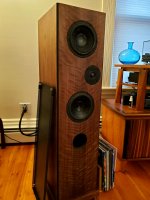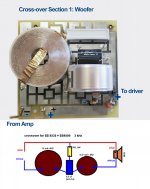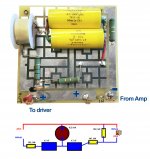I'll try and keep this succinct but a little background: Last year I built what might be termed some "inspired by" ProAc 3.5 clones. 98% of the time: best speakers I've ever had! 2% of time, less so and I'm looking for some insight.
I say inspired by because:
1. I put a great deal more effort into taming cabinet resonance than the originals, which were fairly conventional (all sides use multiple material layers and the front and back walls are thicker than the originals).
2. I used drivers that were as close as possible, but knowing that ProAc had their own drivers customized, it was never to be an identical match.
3. I used very high quality cross-over parts and the general design is based on some classic ProAc 2.5 clones (ProAc claimed they used the same cross-over in both the 2.5 and 3.5). On paper the cross-overs I used looked be a good match for the drivers: two Scanspeak 18W 8545k mid/woofers and a ScanSpeak Revelator D2905/9900-00 1" Tweeter. (Note that the design shows the 8535 but both drivers have the same reccomended cross-over point among other similarities)

The Good: In almost all cases these things sound great! Tight clean bass down to 30hz (though they start rolling off at 40hz). Mids sound warm and natural and plenty of detail in the highs. They can rock hard and yet a female vocalist with guitar sounds delicate and nuanced.

The Problem: At the very upper end of the 8545K's range they are getting some signicant breakup during very particular loud passages. Think: the upper register of a piano being pounded on top of a jazz band that's really jamming out. Or certain sections of a classical symphony or many voices in a choir.
It's not coming from the tweeter; it's absolutely the mids. I'm not over driving the speakers, and the amp is Krell KAV300i (fully class A with plenty of power). I have another system in a different room for surround that, although good, is half the system my dedicated stereo is, and I don't get any noise at all (it also doesn't sound anywhere near as real either).
This issue is not all the time either. I can listen to a dozen albums and not hear a thing, but then, certain tracks (or sections) will make it jump out like crazy. Also, when I do test tones: nothing seems obviously amiss there either, but when it shows, it's impossible to ignore.
Intuition says it is almost certainly that the mid/woofers needs to be crossed over at a lower point. Is there a way to do so without a complete redesign? I assume there must be? I know there are software Sims to use for stuff like this, but to be honest I'm not sure where to start. Plus, this is already built... Thus if anything immediately jumps out to those here with more experience, it would be a huge help!
Thanks!
Note:
Probably the tweeter cross-over point will need adjustment too of course, but as they are on seperate boards I'm inclined to address one thing at a time (if possible). Below is the cross-over for the tweeter (again the driver spec.s out as compatible but is a higher end model).

I say inspired by because:
1. I put a great deal more effort into taming cabinet resonance than the originals, which were fairly conventional (all sides use multiple material layers and the front and back walls are thicker than the originals).
2. I used drivers that were as close as possible, but knowing that ProAc had their own drivers customized, it was never to be an identical match.
3. I used very high quality cross-over parts and the general design is based on some classic ProAc 2.5 clones (ProAc claimed they used the same cross-over in both the 2.5 and 3.5). On paper the cross-overs I used looked be a good match for the drivers: two Scanspeak 18W 8545k mid/woofers and a ScanSpeak Revelator D2905/9900-00 1" Tweeter. (Note that the design shows the 8535 but both drivers have the same reccomended cross-over point among other similarities)
The Good: In almost all cases these things sound great! Tight clean bass down to 30hz (though they start rolling off at 40hz). Mids sound warm and natural and plenty of detail in the highs. They can rock hard and yet a female vocalist with guitar sounds delicate and nuanced.
The Problem: At the very upper end of the 8545K's range they are getting some signicant breakup during very particular loud passages. Think: the upper register of a piano being pounded on top of a jazz band that's really jamming out. Or certain sections of a classical symphony or many voices in a choir.
It's not coming from the tweeter; it's absolutely the mids. I'm not over driving the speakers, and the amp is Krell KAV300i (fully class A with plenty of power). I have another system in a different room for surround that, although good, is half the system my dedicated stereo is, and I don't get any noise at all (it also doesn't sound anywhere near as real either).
This issue is not all the time either. I can listen to a dozen albums and not hear a thing, but then, certain tracks (or sections) will make it jump out like crazy. Also, when I do test tones: nothing seems obviously amiss there either, but when it shows, it's impossible to ignore.
Intuition says it is almost certainly that the mid/woofers needs to be crossed over at a lower point. Is there a way to do so without a complete redesign? I assume there must be? I know there are software Sims to use for stuff like this, but to be honest I'm not sure where to start. Plus, this is already built... Thus if anything immediately jumps out to those here with more experience, it would be a huge help!
Thanks!
Note:
Probably the tweeter cross-over point will need adjustment too of course, but as they are on seperate boards I'm inclined to address one thing at a time (if possible). Below is the cross-over for the tweeter (again the driver spec.s out as compatible but is a higher end model).
Attachments
Re:' the mid/woofers needs to be crossed over at a lower point" - I think that's right, looking at the 8545K data sheet; 3000Hz is the absolute limit
Re:'a way to do so without a complete redesign' - if you change the xover freq. it's a new design....
If you want to subtitute parts in the existing xover, you'd need measurement capabilities to understand what effect they have.
Re:'a way to do so without a complete redesign' - if you change the xover freq. it's a new design....
If you want to subtitute parts in the existing xover, you'd need measurement capabilities to understand what effect they have.
Thanks- good point about the cross-over being too close to the edge of mid.Re:' the mid/woofers needs to be crossed over at a lower point" - I think that's right, looking at the 8545K data sheet; 3000Hz is the absolute limit
Re:'a way to do so without a complete redesign' - if you change the xover freq. it's a new design....
If you want to subtitute parts in the existing xover, you'd need measurement capabilities to understand what effect they have.
I really fail to understand how it is possible to use the same exact crossover designed for a TM configuration onto a MTM. And I'm not even speaking about the change 8535 vs 8545K. IMHO you don't need to fine tune the crossover, you have to redesign it completely.I used very high quality cross-over parts and the general design is based on some classic ProAc 2.5 clones (ProAc claimed they used the same cross-over in both the 2.5 and 3.5). On paper the cross-overs I used looked be a good match for the drivers: two Scanspeak 18W 8545k mid/woofers and a ScanSpeak Revelator D2905/9900-00 1" Tweeter. (Note that the design shows the 8535 but both drivers have the same reccomended cross-over point among other similarities)
Ralf
Ok, perhaps. But the build was predicated on the fact that ProAc itself was on record as saying that the parts in the 2.5 speakers were identical to those in 3.5 except with the additional midrange/woofer unit (and obviously a larger cabinet). Thus having built a set of 2.5 clones successfully some years back, I assumed that I could basically do the same. The problem came when I found I could just buy another pair of the exact same drivers. The newer ones I got spec. out better in many respects but it seems that by being a bit more efficient, that ends up putting too much energy into the breakup region.
I haven't seen what ProAc said, maybe they meant something different from what you understood. The point is that, once you set the crossover point, the crossover component values depend entirely on the impedance of the drivers. And 2 drivers either in parallel or in series have a very different impedance than a single identical driver (double or half). So the crossover designed for a single driver won't work as intended if you put 2 drivers instead of one.But the build was predicated on the fact that ProAc itself was on record as saying that the parts in the 2.5 speakers were identical to those in 3.5 except with the additional midrange/woofer unit (and obviously a larger cabinet).
Just as an example, here is a simulation of a speaker with a woofer and a tweeter, and what happens using the same identical crossover with 2 woofers in parallel (only the FR of one woofer is shown, the combined FR for 2 woofer is +6dB, the summed response W+W+T in blue is right though).
I suspect that ProAc used the same crossover point and slopes between the 2.5 and 3.5 (this makes sense), this in the end means different crossover components for the woofer part and a lesser attenuation on the tweeter (-6dB). You have some homework to do.
Ralf
PS: the 8535 and 8545K have very different TS parameters, and cab designed for one driver won't work for the other. The 8545K is optimized for a small volume, and the 8535 is optimized to give deep bass in an appropriate larger cab.
Thanks- I agree and my feeling is that the big factor that I didn't account for was that they had their drivers tweaked to their needs and naturally what I got was off the shelf (very good off the shelf, but still).
So what should my strategy be? Is it possible via software to plug in the cross-over I have now and see what needs to changed?
So what should my strategy be? Is it possible via software to plug in the cross-over I have now and see what needs to changed?
I don't think your problem lies in the fact that ProAc had custom drivers, the changes from the regular stock is probably minimal, but if you start replacing a 8545K for a 8535 and a 9900 for a 9500 then things can't do well. Using a crossover for a single woofer to a dual woofer implementation is however the main error.
As I said the 8535 and 8545K are very different animals, even if they look similar, and thus require different enclosure and tuning. On a recent thread here (https://www.diyaudio.com/community/...speak-2way-tilted-baffle.388532/#post-7077838), the OP said he obtained the best bass from the 8545K with a 16L box tuned to 33Hz. For two drivers this means double the volume and same tuning. I would start from here.
As far as the crossover, I really suspect you need to redesign it completely, but the project should be doable.
I'd try to cross the drivers at 2KHz LR4, to avoid the HF garbage of the woofers and also for a smooth transition dispersion wise between woofer and tweeter.
Your best approach would be with real measurements (*), but as a start you can simulate with VituixCAD, this way you can import FR and impedance graphs from mfg, modify FR for baffle step and diffraction, give it appropriate minimum phase, set path difference between woofer and tweeter at 25mm as a start. At this point you can import into it the crossover you have now and see what happens. Or decide to start from scratch.
(*) Given the price paid for drivers and also crossover components, I feel that adding some more money for a not USB calibrated mic and an appropriate mic preamp is the wisest investment you can do in order to bring the best from what you have.
Ralf
As I said the 8535 and 8545K are very different animals, even if they look similar, and thus require different enclosure and tuning. On a recent thread here (https://www.diyaudio.com/community/...speak-2way-tilted-baffle.388532/#post-7077838), the OP said he obtained the best bass from the 8545K with a 16L box tuned to 33Hz. For two drivers this means double the volume and same tuning. I would start from here.
As far as the crossover, I really suspect you need to redesign it completely, but the project should be doable.
I'd try to cross the drivers at 2KHz LR4, to avoid the HF garbage of the woofers and also for a smooth transition dispersion wise between woofer and tweeter.
Your best approach would be with real measurements (*), but as a start you can simulate with VituixCAD, this way you can import FR and impedance graphs from mfg, modify FR for baffle step and diffraction, give it appropriate minimum phase, set path difference between woofer and tweeter at 25mm as a start. At this point you can import into it the crossover you have now and see what happens. Or decide to start from scratch.
(*) Given the price paid for drivers and also crossover components, I feel that adding some more money for a not USB calibrated mic and an appropriate mic preamp is the wisest investment you can do in order to bring the best from what you have.
Ralf
- Home
- Loudspeakers
- Multi-Way
- Help fine tuning a ProAc 3.5 clone


